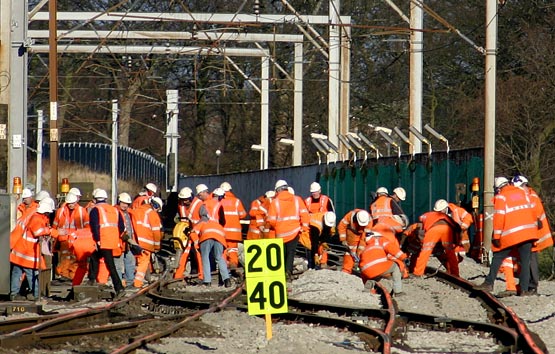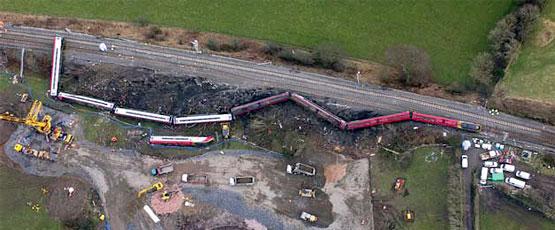|
Given its determination to highlight the potential safety implications of Network Rail’s impending jobs cull, nobody fell off their chair when the RMT declared that the ORR’s recent Prohibition Notice against NR - banning red zone patrols over some structures in South Wales - resulted from a shortage of lookouts. The union quoted an inspector who said that there was "an immediate risk of harm to the trackworkers undertaking foot patrols on the railway line between Cardiff Central and Aberdare, Rhymney, Treherbert and Merthyr Tydfil".
The reality had been distorted somewhat by Mandelson-esque spin. A local source admitted that there are staffing issues in the area but the notice was actually a function of planning deficiencies - the structures in question afforded no position of safety so red zone working would have been unsafe whatever the number of lookouts available. The union’s claim was branded "absolute nonsense" by a NR spokesman.
However, a subsequent Improvement Notice added fuel to the fire. The same inspector made it clear that Network Rail had not "properly implemented the control measures arising out of your risk assessment for red zone foot patrolling…because you have not ensured that the number of lookouts specified in your risk assessment...is always provided and used." It should be noted that this does not mean that insufficient lookouts are employed, just that they weren’t allocated to the relevant tasks.
But even more damning were the inspector’s conclusions. "It should be noted that the failings identified are systemic in nature and are reflected in other formal enforcement action taken by ORR during this and previous years in regard to red zone working. As such, I draw your attention to the possibility that similar failings may be present in other Maintenance Delivery Units across all Routes, and I strongly recommend that you endeavour to use lessons from this action to improve your safety management systems on a wider scale."
Anyone who regularly reads inquiry reports will know that Network Rail already had a great deal of work to do if it was to demonstrate that there are no deep-seated shortcomings within its work planning processes. This latest ORR action - forced under the spotlight by the RMT - serves to steepen the mountain NR has to climb.
 |
| Trackwork on the West Coast Main Line near Lancaster. |
As the spring D-day approaches for the 1,400+ maintenance workers about to join the dole queue, the campaign against the redundancies is going to become ever more spirited. Two unions are balloting members over possible industrial action and the parliamentary Early Day Motion demanding government intervention has, at the time of publication, secured the support of 143 MPs - a very creditable figure.
So is this conflict being driven by a union with its head in the sand or the reckless actions of a company desperate to slash costs at all costs?
Let’s start by establishing one uncomfortable truth - progress is not a bad thing and comes in many different forms, so yesterday’s appropriate staffing levels will not necessarily be right tomorrow. LEDs are signalling the end for incandescent lamps; the worth of Remote Condition Monitoring has become clearer, allowing maintenance manpower to be more effectively targeted; new generation, high-output machines are going to deliver huge advantages over today’s manual and mechanised techniques, causing less disruption into the bargain.
A Network Rail spokesman told People Management magazine recently that "with new technology we need fewer people". He also made the argument that years of upgrading have made the network "a fresher asset, so intensive maintenance was not necessary". Both reasonable points.
What he didn’t say though was that the 'fresher asset' is now expected to handle a greater intensity of traffic than it has historically, resulting in more wear and tear. Neither did he acknowledge that, in many cases, the 'new technology' is not yet proven, or even fully developed. There is a huge maintenance backlog in places, with some vital repairs being delayed by weeks or months.
|
| There is a huge maintenance backlog in places, with some vital repairs being delayed by weeks or months. |
|
There was no mention either of the extent to which several depots are being dismantled. Amongst its maintenance teams - that’s p-way, off-track, rail management, S&T, OLE and distribution & plant - the headcount at Preston will be cut by 101, a reduction of 30% from the current figure of 337. Forty new posts will be created through the setting up of Works Delivery Units for both track and signalling but these will carry out additional life-extension and renewal jobs. Carlisle will see 69 men leave with 38 positions established in WDUs. Across the two depots, one-in-four of the maintenance-focussed staff will disappear.
|
| Preston Depot |
Current headcount |
Proposed headcount |
Difference |
| P-way |
140 |
106 |
-34 |
| Off-track |
20 |
16 |
-4 |
| Rail management |
40 |
19 |
-21 |
| S&T |
57 |
46 |
-11 |
| OLE |
64 |
40 |
-24 |
| Distribution & plant |
14 |
7 |
-7 |
| WDU track |
1 |
26 |
+25 |
| WDU signalling |
1 |
16 |
+15 |
| Totals |
337 |
276 |
-61 |
|
|
| Carlisle Depot |
Current headcount |
Proposed headcount |
Difference |
| P-way |
200 |
162 |
-38 |
| Off-track |
22 |
24 |
+2 |
| Rail management |
41 |
26 |
-15 |
| S&T |
78 |
60 |
-18 |
| WDU track |
0 |
22 |
+22 |
| WDU signalling |
0 |
16 |
+16 |
| Totals |
341 |
310 |
-31 |
|
|
Network Rail is under ever-increasing pressure to maintain, renew and expand the network efficiently and effectively, whilst delivering a 'seven-day railway' and receiving lower levels of public investment. No-one should underestimate the scale of that challenge and the conflicts it throws up.
But neither should we lose sight of what might happen if Network Rail gets it wrong. Grayrigg sits mid-way between Preston and Carlisle. The inquiry into the derailment there three years ago found that workload, extended working hours and staff shortages were all factors that might have resulted in crucial inspections being missed. Have the pressures there diminished to such an extent that a hundred men can now safely leave the building? What happens if the new technology doesn’t perform as anticipated or more equipment failures than expected occur as a result of extended inspection timescales?
 |
| An aerial view of the Grayrigg crash scene.
Picture Source: RAIB Rail Accident Report (Crown Copyright)
|
What Network Rail plans to implement in April is based on a calculated gamble. Teething troubles have beset some of its new machinery; the processes needed to harness it to the fullest extent are not yet all in place. Today’s needs cannot be put on hold whilst we wait to reap tomorrow’s benefits. It might well be that more than 1,400 men eventually become surplus to requirements. Progress can bring such changes - but it doesn’t bring them overnight. Right now, the new dawn is barely a faint glow. Timing is critical; so is the ongoing integrity of the maintenance regime.
Story added 1st March 2010
|